Newsletter 143, September 2022

In this issue
President's Update
Hello everyone, July and August have been dominated by activity in promotions and responding to government regulatory changes. Some days there appears to be light at the end of the tunnel and some days it turns out to be a train. We live in interesting times. With so much change occurring, I have thought it timely we revised the organisation’s Strategic Plan and have provided an initial draft to the Executive for improvement. It will be finalised after we get the Consultant’s report and will be presented to the next Council meeting for consideration.
Membership Services Working Group
This group (Liz, Don, Dean, Howard, Michael G, Mike O, and I) have met several times and currently focus on improving the subscription payment system. Dean has several improvements in development that we expect by the end of September. It will then be tested by this group. Our challenge is to get this completed before the new round of subscriptions are due. When released, we welcome comments and feedback on your experience with the improved system. We have also had our consultant group (Element Environmental) look at the web site and survey users.
National Field days Forestry Hub
The Forestry Hub working group (TUR/NZ FS, FGLT and NZFFA) have been busy with designers and coalescing exhibitors. It’s all now taking shape and many parts will need to be brought together near the end of November. About 26 exhibitors will be on the Forestry Hub site. There has been great industry support and many exciting things will be on display. Several new technologies and research results are being demonstrated to engage the rural sector.
Promotion
This week the first 10 roadside billboards are being printed. Forest Owners Association will be doing something similar, but we have developed our own catchphrases that are more orientated toward farm forestry principles. The five branches involved in the first billboards have had input on the wording for their district’s billboards. Each billboard will use a common background with our logo prominent. The Levy Trust has constituted a new promotions committee with new people and new ideas. We have been promised levy funding and support for our billboard programme. Details around the previously mentioned branded clothing are being released. I have trialled a branded business shirt and jacket and very pleased with the quality.
Implications from Government
There are numerous developments in government policy that we are making submissions on or providing input to officials via Zoom. Most of these will have impact on members. They are:
- NZ ETS Small Foresters Surrender/Repayment Penalty Consultation
- Regulation of Log Traders and Forestry Advisors
- Draft Industry Transformation Plan
If you wish to be involved with any of these feedback processes or have suggestions, please don’t hesitate to make contact or forward comments.
Research applications
Many of the Executive have been developing projects or supporting Action Groups to apply to the Levy for research funding next year. These are channelled through the various levy committees (SME, Transport, Training, Environment, Promotions, and Research) and are projects orientated toward helping Farm Forestry. A total of 15 applications requesting $641,000 have been submitted. We don’t expect to get all the funding, last year we achieved about a 54% success rate.
Fund raising facilitation
Our contracted consultancy firm (Element Environmental Ltd) has been active in collecting information and we have received their stage 1 draft report that will be considered at the next Exec Comm meeting. Already we have received some very useful insights on what our members, sponsors, and partners are suggesting as improvements. We will provide a full report at the next Council Meeting in November.
Graham West, NZFFA President
Offshoots
- Safetree newsletter
- Forest Biosecurity News Issue # 2
- Draft forestry sector plan aims form more onshore processing, biomass fuel
- Help organise the content in the Emissions Trading Scheme (ETS) section on the MPI website. Start activity now
- TUR consultation on draft Forestry and Wood Processing Industry Transformation Plan & Forestry & Wood Processing Workshops
Events
For more information on these events, they are posted on the NZFFA website »
Branch secretaries, please make sure you notify head office of any branch or action group events.
- Save the date - Hawke's Bay Branch Field Day - Rangitoto Station Saturday 15 October 2022 Field day at James Hunter’s “Rangitoto” property to celebrate him winning the North Island Husqvarna Farm Forester of the Year Award. Rangitoto Station, 1691 Blackhead Road,…
- Forest Growers Research Conference - Forestry for the Future 18 - 20 October 2022 Rutherford Hotel, Nelson Queries forestgrowersresearch@fgr.nz or phone 07 921746 REGISTER HERE
- Tane's Tree Trust - O Tatou Ngahere Conference Regenerating our Landscape with Native Forest 27-28 October 2022 Te Papa Tongarewa, Wellington. Tāne’s Tree Trust has partnered with Pure Advantage to produce a two-day conference at Te Papa Tongarewa on 27-28 October 2022.…
- Save the date - Hawke's Bay Branch Field Day - Nisbett Taumata Estate Thursday 17 November 2022 Field day celebrating Pac Pac HB Farm Forester of the Year Steve Treseder on the Nisbett Estate, 625 Te Awa Road, Waipukerau. Details to be confirmed…

Tree Grower articles
- Advances in cypress research A summary of the activities of Specialty Wood Products The Specialty Wood Products research programme draws to close in 2022. Species included are Douglas-fir, cypress along with durable and non-durable eucalypts. This article is about the results of the…
- Predicting the shape and volume of Eucalyptus globoidea heartwood What do eucalypts have in common with sauvignon blanc? Why will durable eucalypt posts be a critical part of New Zealand’s vineyard landscape in future and how do taper and…
Headlines
- Forestry Transformation Plan could be ‘game changer’ August, 2022. Forestry Transformation Plan could be ‘game changer’ for New Zealand economy and for combating climate change The Forest Owners Association says the Forestry and Wood Processing Industry Transformation Plan has…
- New campaign launches to attract more people into forestry careers August, 2022. A new recruitment campaign called ‘Find Your Fit In Forestry’ aims to draw attention to the varied career opportunities available in the growing forestry industry. A sector-wide initiative, the campaign…
- Trees on Your Farm – Pilot Workshops July, 2022. In May, members of the NZFFA held three pilot workshops in the lower North Island aimed at encouraging hill country farmers to grow more trees. The format was a day…
- Federated Farmers struggling with both the law and arithmetic June, 2022. The Forest Owners Association says Federated Farmers have got their sums wrong on the rate of forest planting and don’t understand the law on overseas investment either. FOA is responding…
Proud to be a Farm Forester
Be a Proud Farm Forester - get your gears on!
Cathie Forde has organised for us NZFFA branded clothing and it looks great. Find the order form and clothing details here.
Pictured is our esteemed leader NZFFA president Graham West, modelling the navy soft shell jacket with NZFFA logo & the Hudson business shirt with NZFFA logo.
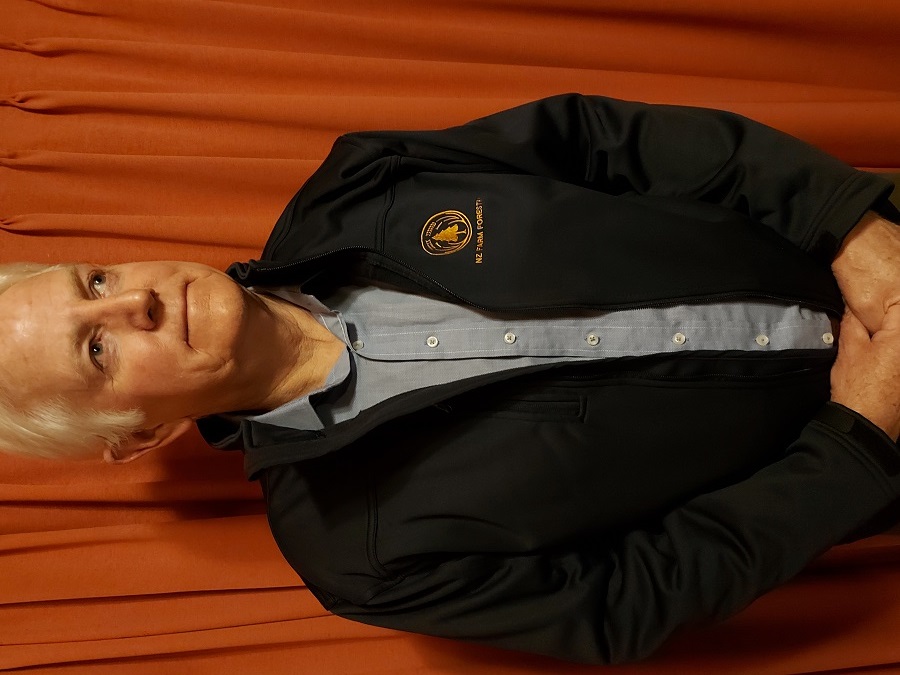
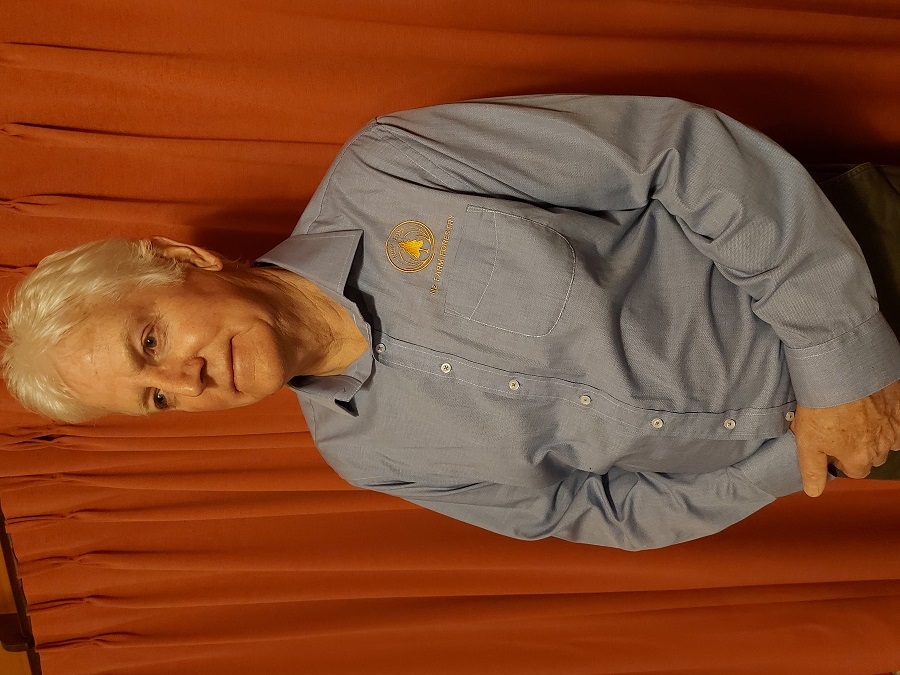
Industry Transformation Plan - Diversifying our productive forests to build sector resilience
The Forest Owners Association asked me, as an ITP Advisory Group member, to prepare this piece for the FOA Forestry Bulletin, duplicated here:
Throughout the media one clear message prevails about planting trees and forests: Either plant pines, or plant natives. Apparently those are the only options. Forest Owners have no reason to counter that, growing pine after all is business as usual. One species and one wood, where “wood” and “radiata” are interchangeable terms and serve both the forest and wood processing industries well.
The Industry Transformation Plan, on the other hand, is about innovation that leads to a prosperous future industry. Wood is as diverse as the tree species that produce it, and this was identified by the advisory group as a clear opportunity industry should not ignore. Although diversifying into specialty timbers does challenge that “business as usual” model, the opportunity for industry to mitigate both biological and business risk is real and significant.
The other reality is that the forest industry has, rightly or wrongly, earned a negative and highly-charged reputation for being an unsustainable pine monoculture. That reputation will continue to erode the forest industries social licence to operate. Everyone knows that pines poison the soil and deplete biodiversity. Well, that’s what I’m being told all the time in my role as land management advisor. Just ask any farmer or city dweller. Whether right or wrong, people hear what they want to hear, not necessarily what is fact. The public, as holders of the forest industries social licence to operate, demand genuine narrative and tangible change where they see this is required, so distrust glossy promotional campaigns because these are perceived to disguise business as usual.
Add to this the Climate Change Commission jumping aboard Dame Anne Salmond’s vision of vast areas on New Zealand covered in planted native forests, to counter the villain monoculture pine industry. Let’s not kid ourselves, the economics of growing native plantations for timber don’t stack up, the Forest Service figured that out early last century. Anyway, reinventing that wheel would require significant research investment, with no guarantees of returns. More importantly, before deploying native timber plantations at scale, decades of trials would be necessary to inform productivity models.
The ITP working group did our best to get this through to a native-indoctrinated Te Uru Rākau. Unfortunately that bandwagon is well rolling, in my view prematurely gaining momentum and with no thought being given to the circumstances where land should be retired from production. In my opinion FOA haven’t helped the situation by partnering with Te Uru Rākau in their “It’s time for wood” campaign that centres around regional economic development based on “indigenous trees and their timber’s appeal as an alternative to importing tropical hardwoods”. This sets the stage for “them and us” (heroes and villains), and a lost opportunity of epic proportions unless industry steers a new path to diversify our productive species mix. The handbrake as I see it is corporate sector motivation for change, and at the scale required for success.
To shed the evil reputation of a “monoculture” industry, serious investment in diverse species for wood production is required, in partnership with government. The Specialty Wood Products programme has made good progress and the knowledge gaps are being filled. We just need to refocus investment and understand that levies accrued from radiata logs don’t necessarily need to go back into radiata, but instead where strategic industry investment is most needed. The R&D deck has been stacked against alternatives for 80 years, so no wonder preconceptions abound within the forest sector. Despite this, there are good initiatives being undertaken to commercialise redwoods, cypress and eucalypts, fast-growing species not only offering diverse wood products, but also opening the door for continuous cover forestry on steep slopes.
If, as the forest industry, we were to seriously invest in exotic species that produce high-value specialty timber, not only would we open new market opportunities while addressing species concentration risk, but done right we’d also transform our social license to operate. If industry doesn’t take that initiative then the politicians will fill the void with vast native afforestation of pastoral hill country, to satisfy their climate response agenda and the publics thirst for diversity. The promise might be that native trees produce high-value timber, but my experience says otherwise. Native canopy species are difficult enough to establish successfully in pasture, but worse because their ecology is to emerge through pioneer scrub species, producing straight stems requires extremely complex silvicultural systems that are currently only being imagined. But politicians don’t always get reality.
Shade tolerant, coppicing species like redwoods and eucalypts mitigate landslide risk under a continuous cover regime, so what level of slope is too great for production forestry? Rotation forests have a much lower slope threshold, implying that land deemed unsuitable for clearfell has nil capital value. Under that scenario, are the higher harvesting costs of single tree extraction justified for high-value timber species? Without knowing the answer to that, forest owners only have assumptions when weighing risk to replant orange and red zone land against retirement. Pastoral land owners consider only two tree planting options for their hills, rotation pine or native retirement, with no species or landslide risk information. Becoming informed would begin the paradigm shift, but that also means progressive thinking. My favourite quote, "Paradigms fall slowly, from the weight of repeated failure", reflects only the lack of industry imagination.
It’s achievable to provide sustainable wood production and biodiverse, rich outcomes for society by diversifying the productive species mix. But an industry vision and a commitment for action is required to bring government along for the ride, with both parties serious about delivering the goods. The small forest grower is already there.
Dean Satchell
Comment on this opinion piece here »
South Otago Field Day at Milligan’s Property, Dipton
Field Day Report extracted from the South Otago August NewsletterA cold and windy afternoon greeted us as we gathered at Graham Milligan’s woolshed to hear about his current eucalyptus logging. 18 attendees listened to the first guest speaker, Greg Lindsay of Log Marketing, who spoke about buying eucalypts. Graham is currently logging a large amount of eucs. The Chinese market is chasing the A grade and pruned butts of 37+cm, to be used for furniture. They will also take the K grades which are used for veneer. Eucs were $40/t behind radiata export logs a few months ago, but are a bit better now and are giving the best price for many years. A boatload is sent once a month carrying up to 7,000m3. The Chinese are lenient on branching, allowing two or three knots up to 20cm in a 3m length. The Branxholme mill will take some non-export logs. 1,000t has been logged so far.
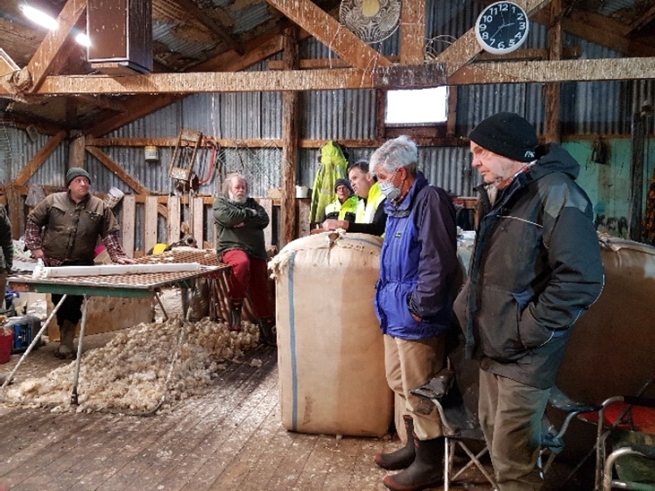
Gathering in the Woolshed
The issue with the large cut trunks is the splitting, so wax has to be sprayed on both ends to slow this. The logging team have to handle the wood carefully to minimise damage. A feller buncher is used for felling the trees, as well as some hand felling. Graham has a mixture of regnans and nitens eucs but they can be mixed for shipping.
Graham planted his first lot of eucs 36 or 37 years ago, on the advice of Dudley Franklin, and was holding on to them for a better market, but decided Log Marketing’s was the best offer he had received so far and would take the money. Pines had been grown within the euc plantations – the euc rows are 10m apart - and these had been harvested eight years ago. Graham mentioned that wide spacing is necessary for eucs to be able to grow in diameter. The flat, lower altitude plantations have also been used for grazing. Graham will replant in eucs.
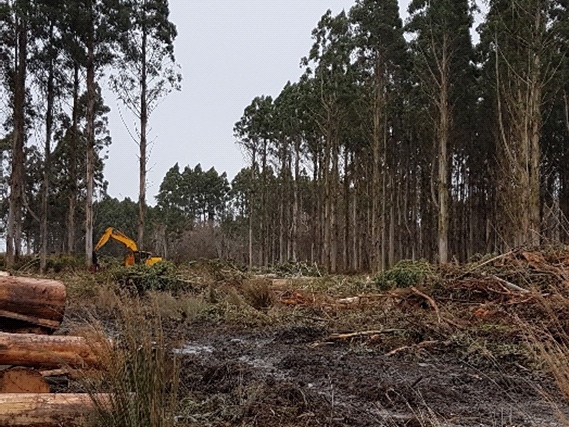
The Eucalyptus being logged
Our first stop on the tour was at the skid site. There were impressive logs to be seen and watching the felling and processing was fascinating. Greg said the piles of slash would be burnt, as there is currently no demand for biofuel. The cost of harvesting has gone up, largely due to the rise in fuel prices, costing an extra $4/t. The advantage for the harvesting crew on this job is that the trees are heavy – 2- 3t a butt, or 5-6t each tree – but the disadvantages of eucalypt harvesting are that it is very hard on gear especially on the chains, the limbs on trees are problematic, and each end of a log has to be sprayed, a manual process requiring frequent cleaning of the spray equipment as it clogs easily with the wax.
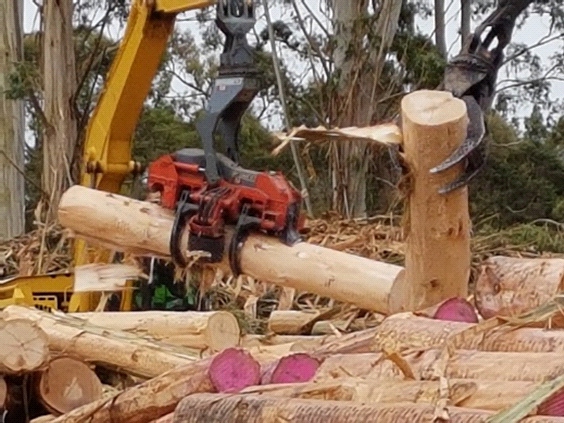
Careful Handling
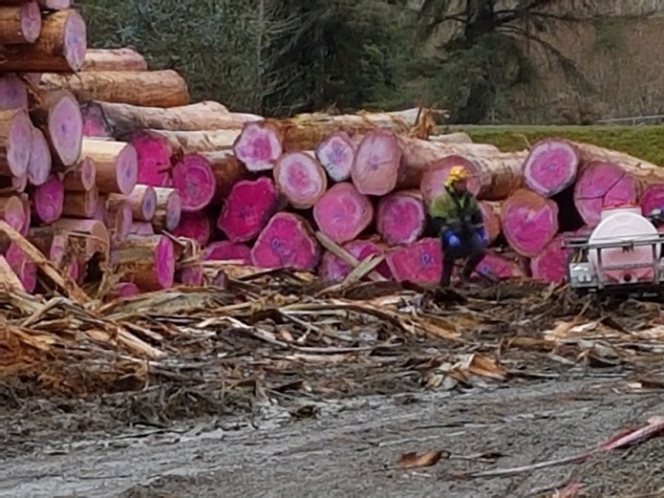
The chap spraying the wax puts the size of the logs in perspective
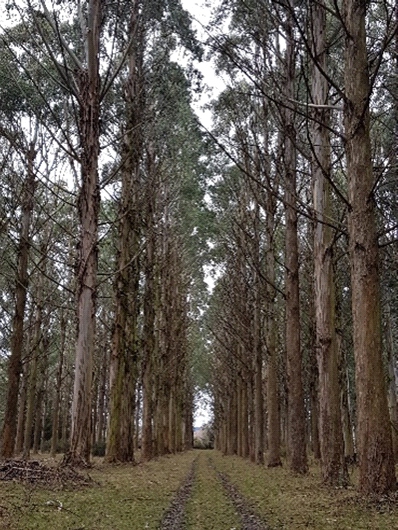
A eucalyptus block yet to be logged
At our final stop on the tour, we viewed a radiata site which had been logged last year. Warren Heslip (Heslip Forest Contracting) had organized that job and talked to us about it. The incidence of wildings and attack by hylastes (bark beetle) seems to be a matter of chance – sometimes it happens, sometimes it doesn’t. Graham will replant here in October, after letting the gorse and broom grow up and spraying it in September. An adjacent site logged four years ago had been sprayed for broom, and the wildings had been hand-pulled at a cost of between $280-340/ha (using saws/loppers would cost between $500-600/ha).
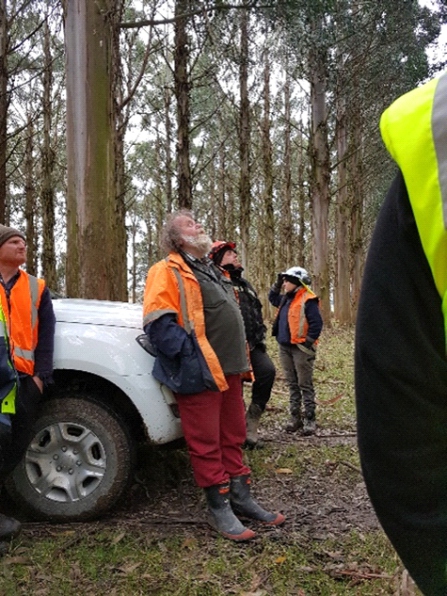
They're so tall!
Many thanks to Graham for arranging a very interesting afternoon.
What would ole' Gus think?
Warwick Hesketh, Hawke's Bay Newsletter EditorAfter several years of trying, we finally managed to deliver an autumn field day at the Guthrie Smith Arboretum…
The arboretum has been described as one of Hawke’s Bay’s best kept secrets… clearly not to farm forestry folk though, as we were joined by members who’d made the trip over from the Rangitikei and Manawatu.
The 90ha arboretum is mostly part of a 2,000 acre block that renowned farmer, author and naturalist Guthrie-Smith bequeathed in trust for the nation. Mike Halliday has been a trustee since 2009. Mike introduced the day and led a brief tour, outlining some of the history of the arboretum, plans currently underway and more going forward.
Our first stop was to view an impressive stand of Mexican oak that had been planted on a particularly erosion-prone area of the arboretum. These trees have performed exceptionally well, with growth rates comparable to radiata pine. Mexican oak timber has a range of uses internationally, from furniture and flooring to wine barrels and even cosmetic cream. Another versatile and potentially lucrative hardwood to add to the list.
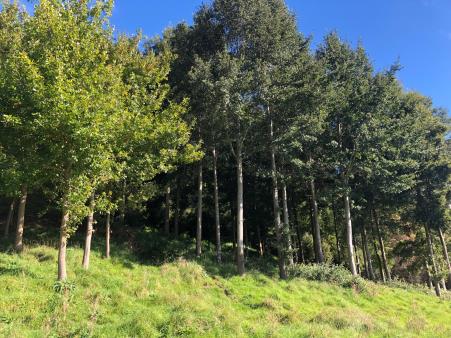
A nice stand of Mexican Oak Quercus polymorpha
From here we had a good view of the Arboretum’s latest project. Plans are in place to develop a 4ha wetland on the ‘Sanctuary Block’ - land donated to the arboretum by Stuart and Alison Riden. Work is well underway clearing some big old poplar from the site. $85,000 has been set aside from the Te Waiu O Tutira project for the design-work and Resource Consent process.
Once consent is granted, Mike expects works to progress relatively quickly. The wetland will look a picture from the road, and will compliment Lake Tutira and the surrounding forest park nicely.
The Arboretum’s location offers some pretty spectacular views over Lake Tutira. Steep hill-country above the lake’s eastern margin is now dominated by planted and naturally reverting manuka. In 2011, HBRC established 100ha of high UMF manuka in a partnership with Comvita. the manuka has grown remarkably well, but much to the delight of naysayers, early returns from honey production have been below initial expectations. Also, naturally regenerating (non UMF) manuka and kanuka is beginning to outcompete the ‘flash stuff’.
HBRC Forests manager Ben Douglas was on hand to help put things into perspective. Even when considering establishment costs and a lower-than-expected revenue from honey, the returns from carbon alone have provided a positive return on investment. This is before considering the biodiversity and erosion mitigation benefits in this sensitive lake catchment.
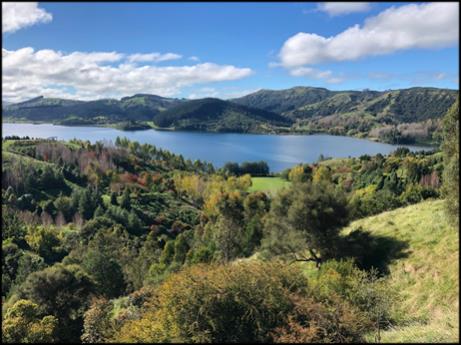
The Guthrie Smith Aboretum and lake Turia in autumn - not too shabby
After lunch we were given free range to explore the arboretum, in what will have been the closest thing to world travel that any of us had experienced in some time.
The concept of planting ‘world regions’ was first initiated in 2002. Since then, over 20,000 trees have been planted, many arranged into groupings that represent different countries and geographical regions. It was quite mind-blowing to see how much these trees have grown since my last visit a dozen or so years ago. I was also impressed by what must be quite a few kilometres of well-maintained trails. After making my way through Australia, I spent some time in Asia and North America before seeking out the familiarity of New Zealand. For the uninitiated, it’s a bit of a hike down to Lake Orakai, but well worth it. Just allow yourself plenty of time to get back up.
Overall, a nice day out with the autumn splendour very much worth the wait. This is not to say that the arboretum isn’t worth a visit at any time during the year. I’m picking my next visit will be late winter/early spring to see the prunus/cherries in bloom. I reckon Guthrie Smith would have to be ‘pretty chuffed’ with how things have turned out.
|
President: Graham West westlanduse@gmail.com Newsletter editor: Dean Satchell dsatch@gmail.com National Office: Liz Chamberlain admin@nzffa.org.nz Phone: 04 4720432 |
Members |
| Disclaimer: Personal views expressed in this newsletter are those of the writers and do not necessarily represent those of the NZ Farm Forestry Association. | |
 Farm Forestry New Zealand
Farm Forestry New Zealand